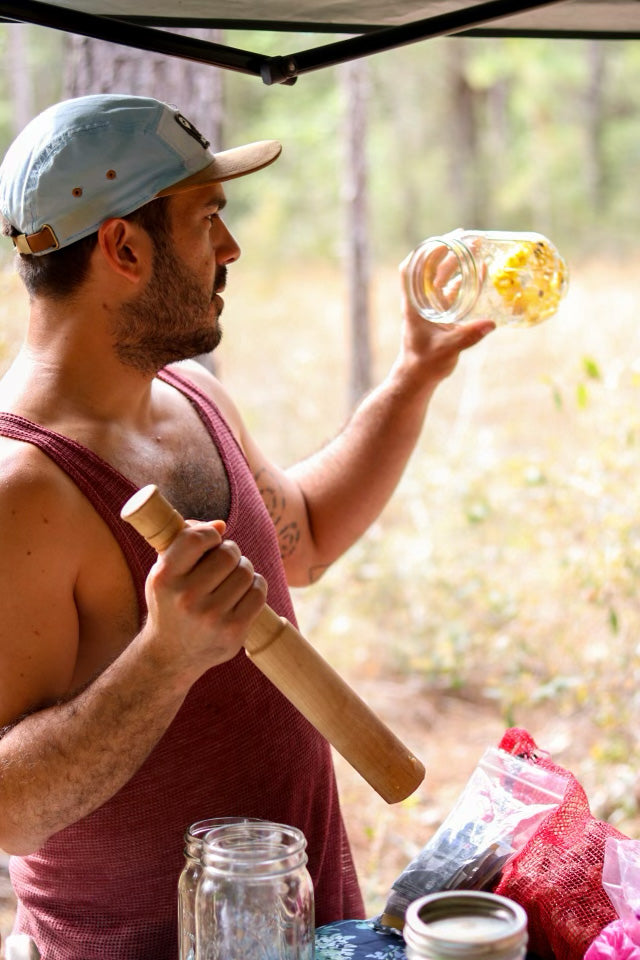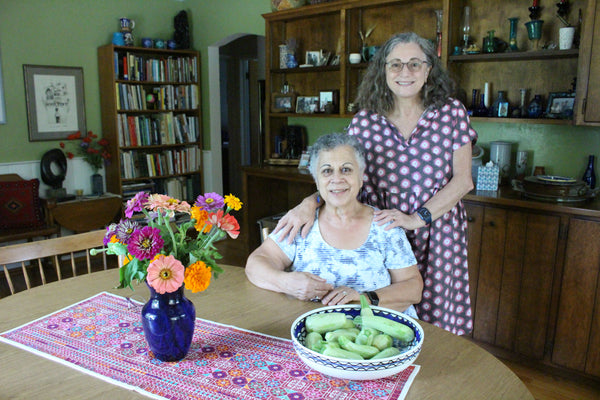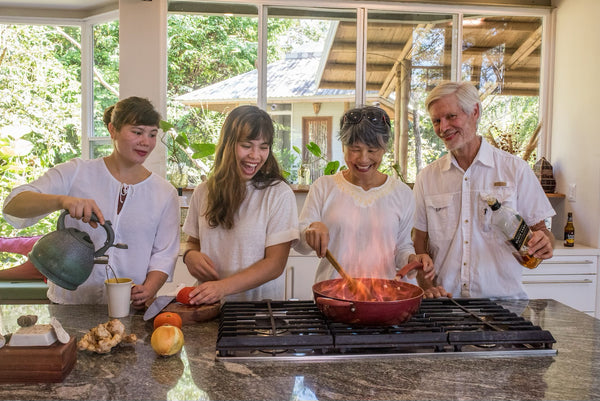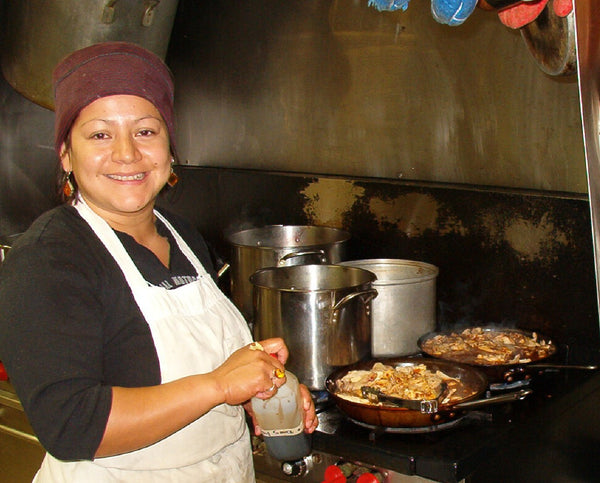Darich (pronounced “Dah-reach”) was born and raised in a town near the capital of Puerto Rico called Trujillo Alto. Based in New York, right now he’s traveling to and from Florida selling his ferments at markets along the way. He also teaches Fermentation Workshops and has Fermentation Dinners, where he serves a five-course meal with each dish featuring a different kind of fermentation. Not only does Darich serve as a Fermentation Revolutionary; seed saving, planting, maintaining, and harvesting are also a core component of Darich’s raison d’être. He claims that his grandmother, Roselia Gil Peréz, instilled in him much of this passion for plants, and I can tell from the way he speaks about her that he regards her with deep respect and love. He tells me that she is an amazing, “next level” gardener, cook, and herbal medicine woman. Beyond his grandmother’s initial inspiration, Darich has done his own research on and experimentation with both traditional foods and ferments of Puerto Rico and with those from the rest of the world. For Darich, experiencing different food traditions, especially those of his ancestors, helps him get closer to his true identity. “My identity through food becomes more rainbow the more I look at it. It only makes me feel closer to other traditions and cultures. I understand now that we are really just one family that has been separated into different cultures around the world, creating a beautiful quilt of traditions.”

Pictured: Darich teaching at one of his Fermentation Workshops.
Islands, Pigs, and Rooftop Gardens
I met Darich while visiting my friend Caroline at a small, regenerative vegetable farm down in Gainesville, Florida. We had just spent a hot, sunny morning helping weed and prep for market, and after a cool dip in a nearby spring, we hopped in her car and prepared to head home. Just as Caroline turned the keys, a man, carrying two heavy-looking 5-gallon buckets, appeared from the forest bordering the property. “Who’s that?” I asked. “Oh! That’s Darich. He’s been staying at the farm the past couple weeks. Hi Darich!” Caroline waved and rolled the window down. A gigantic grin split across his face and he changed course for our car. We found ourselves talking seeds, farming, and ferments for the next good while. We learned that the gigantic buckets he was carrying were full of fermented ginger beer he’d brewed for the farm as a gift for hosting him. I knew in that moment we’d be friends.

Pictured: Darich's sweet grin :)
Although Darich has lived in the United States for the past seven years, he spent most of his life in the northeastern region of Puerto Rico near San Juan. Puerto Rico is a small island in the Caribbean and an unincorporated US territory with a population of 2.8 million people. Its ecosystems are as rich and diverse as its people, who are Taíno (an indigenous people who have inhabited much of Central America for generations), Spanish, African, and more. Puerto Rico’s history is very complex, involving the Atlantic slave trade as well as generations of colonialism which resulted in a great diversity of cultures and ethnicities. (To learn more about the history of Puerto Rico, click here).
Darich was the first in his family to attend college, and immediately fell in love with learning when he began school at the University of Puerto Rico. He studied everything from psychology to education to history, all the way to interior design and sociology. Darich had so many interests and passions. He could never quite seem to finish studying one thing before he’d taken up another, but finally, he decided to do a Culinary Arts program for a year to prove to himself that he could finish something. After that, he became very interested in food and farming, and began looking for opportunities for WWOOFing in the States. He blames his grandmother for inciting this passion in him for travel; “Before I left home, my grandma told me, ‘you don’t have any kids yet, you are free! Go and explore the world.’ I took her too seriously, and now I’m traveling all around the world!” He chuckles to himself.
Darich’s earliest memory of being introduced to ancestral foods occurred when he was about 4 or 5 years old. His grandmother, with help from the rest of his family, had prepared a gigantic, Puerto Rican-style feast, with entire roast pigs (lechón) laid across the table, slathered in Adobo seasoning and slow-roasted on a spit above a firepit outside; arroz con gandules (rice with pigeon peas); morcilla (Puerto Rican blood sausage), and a whole slew of desserts, including pasteles puertoriqueños (root veggie patties filled with meat), arroz con dulce (a sweet rice pudding), tembleque (coconut rice pudding), majarete (corn pudding), and coquito (a sort of coconut eggnog, usually alcoholic). This type of feast is most typically seen at Christmastime, but can be prepared at any time of the year. Darich remembers the feeling of ceremony and community, the amazement at the extravaganza of this meal. “Everything is a celebration in Puerto Rico,” Darich says, “we love any excuse to celebrate!”

Pictured: Darich's grandmother with her beloved plants.
Growing up, Darich’s grandmother took care of him while his mother worked during the day. Consequently, he spent a lot of time in the kitchen with his grandma, either helping her prepare, or eating what she had created. “My grandma can make anything,” Darich says, “Back in the day, I remember my grandpa would find a coconut for her, and she’d process it herself. She’d scrape the meat out, boil it, and squeeze the milk out to make dessert. Instead of just buying a can of coconut at the store. She was like, another level.” He remembers his grandmother’s garden was always flourishing; she kept everything from recao (aka “spiny cilantro” or Culantro), to sweet pepper, to pineapple (“she’d buy a pineapple from the market and would plant it so it would grow more pineapple”), to a variety of medicinal plants, and more. “Seeing her cook with all these traditional foods made me want to seek tradition, to know more about the way people did things in the past. That was stimulated by her. And I feel now, after many years of learning and practice, I can hold that heritage of her flavor, I can imitate it. And that’s something I feel proud of, because that food will be cherished at least a little bit longer.”
At one point in his twenties, Darich was living in an apartment next to his grandma’s house. They were located in a more urban setting, and there wasn’t a lot of space to keep the incredible diversity of plants his grandma was growing in her backyard. In order to give her more space to garden, they created a rooftop garden on top of his apartment. They started growing a huge amount of gandules (pigeon peas); a specific variety Darich had found through a group of older farmers in that area that is black, high-yielding, and quite rare. They kept a variety of other plants on the rooftop as well, like bananas, yucca, and other roots, which they would plant into repurposed washing machine buckets. Darich helped his grandma out a lot with growing and harvesting the pigeon peas, and so now, whenever he goes to visit, his grandma always has gandules saved for him to make rice with. “It tastes like heaven,” he says, reminiscing on the flavor of his favorite peas.
Between the rooftop garden, helping his grandma in the kitchen as a kid, and partaking in the lavish feasts common to Puerto Ricans, it hasn’t been difficult for Darich to recognize the relationship he has to his ancestors and ancestral foods. Even from a young age, he could feel the power in that connection, and throughout his life, he has nurtured and fostered that sense of belonging and community through food and ferments.
Pique and Other Ferments
I wanted to know more about types of ferments Darich has learned about that are part of his Puerto Rican ancestry and culture. For those who are unfamiliar, fermentation is the process of preserving food and transforming its flavor by subjecting it to beneficial microflora such as bacteria or yeast microflora. Examples of fermented foods include vinegar, wine, cheese, sauerkraut, kimchi and pickles.
“We have a fermented hot sauce in Puerto Rico called pique, and it comes from the caballero pepper grown in Puerto Rico. It means ‘gentleman pepper.’” Darich says with a laugh. His grandma initially taught him how to make it, and he’s made it almost every year since he moved to the States. It’s almost like a vinaigrette, but spicy; instead of chopping or blending the peppers and other ingredients together (which can include everything from pineapple and other fruit to a variety of spices and herbs), everything’s put whole into a bottle, filled the rest of the way with water, and left to sit out in the sun all day. “The next day, it’s already bubbling and effervescent,” says Darich. In Puerto Rico, the sun is much hotter, and so while it may take a day to ferment there, it may take something like 2-3 weeks here in Michigan! Darich’s spices of choice for his fiery vinaigrette are ginger, garlic, and black pepper.

Pictured: pique sitting out in the sun.
He’s tried to grow the caballero pepper himself in New York, from seeds his grandmother gave him, but hasn’t had much success. Their temperament seems to be as spicy as the sauce they produce. “Pique is a staple in Puerto Rico, you’ll see people on the side of the road selling it everywhere,” Darich says. “In Puerto Rico, we eat a lot of heavy foods, like rice and beans, pork… pique is something that’s been prepared since the Taíno peoples. . .. they somehow knew that putting the pique in the food is helpful to digestion [of heavy foods] because it’s fermented. We eat it because it tastes great, but it also serves as an aid in digestion.”
There’s also maví, a drink similar to rootbeer, made from fermenting the bark of the maví tree. Maví is made by boiling the bark, ginger, and cinnamon bark, letting it cool, and straining that liquid into a bowl. More water is added, along with sugar. This mixture is then put out to ferment under the Puerto Rican sun for the day. Similar to pique, you can often see street vendors selling it outside all over Puerto Rico. “It’s something so traditional that there aren’t any regulations,” Darich tells me, “you can just prepare it in your house and sell it. It might end up a little alcoholic, like kombucha, but not enough to get you drunk.” For an entire year, Darich experimented with making maví constantly until he got the flavor that he wanted. Some people will use yeast to let the drink ferment, and some people let it ferment naturally, with whatever yeast is already in the air surrounding it.
And then there’s vinegar. Puerto Rican vinegar is unique; it is made with yellow plantain peels. The peels are placed in water along with a little bit of sugar, and are then left to ferment to taste, usually a couple weeks or so. First, the concoction will become wine (alcoholic), and then, the wine oxidizes and transforms from ethanol into acetic acid (vinegar). Click here to learn more about how vinegar is made. “It’s this brilliant way of composting,” says Darich, “you can ferment this way with any kind of fruit peel, apple core, sweet potato skin, or whatever, and it becomes vinegar.” Darich tells me he makes a lot of vinegar, both intentionally and accidentally. In Puerto Rico, vinegar can be used with any food, similarly to how pique is used; over tostones, rice and beans, plantains, for cooking, and more.
Last but not least; sugarcane fermentation. Puerto Rico is well-known for its rum, which is made from the fermentation of sugarcane. For over a century, sugarcane was the most important cash crop in Puerto Rico. The production of sugarcane is deeply entrenched in generations of colonialism and slavery. When slavery was legal, people were forcibly brought from Africa to cut sugarcane, which is incredibly difficult, backbreaking labor. In 1873, when slavery was abolished in Puerto Rico, the production of sugarcane fell into the hands of the working class. So, while delicious, the production and consumption of sugarcane and its assorted by-products has a complex past.
Sugarcane can be processed not only into rum, but also into molasses, vinegar, mead, and more. Throughout his experience as a farmer, Darich has learned that sugarcane is not only delicious to humans, but can also be used, in its form as molasses, as a fertilizer applied to certain crops. “The idea here is that you have bacteria underground that feed on sugar, and if you feed them, you’re helping to create a better ecosystem in the soil.”
Throughout the years, Darich has learned about and experimented with a great variety of ferments, not just from Puerto Rico, but from all over the world. “When I prepare a ferment that’s traditional in Puerto Rico, it’s unique, something people [in the U.S.] have probably never tried before. Sharing something in that way is really special, and I see it help build community in this really beautiful way.”
The Kindness of Seeds/A Whole Rainbow in One Seed
Throughout our conversation, Darich mentioned several times that he saves a lot of his own seed, that it’s something that feels really important to him, and like such a natural, obvious thing to do. I asked him why this is so important to him, and his response was so beautiful:
The first time I planted seeds was in preschool. I planted a bean seed. It gave me such a sense of abundance, of ‘Oh, I can plant this seed and get many more seeds from that!’ I also remember my grandma planting and saving seeds, and seeing how easy it was to just plant a seed and get a lovely vegetable or fruit. Slowly, over the years, I’ve been saving my own seed. It’s very important to me because it preserves the seed’s identity, but also, when you are the one who is taking care of the same plant for many years, it gives the plant a different identity than one that is growing elsewhere under different conditions. Saving seed creates identity. Seeds are so kind, they give so much - so why not save seeds?
Planting and saving corn seed has become a particular obsession for Darich in recent years. This year, at a friend’s farm down in Florida, he planted a bunch of different corn varieties in the same plot. “I’ve been growing this corn together every year, and every year it’s different. I’m not trying to create a variety. I like change. I don’t want to be put in a box - I’ll just break it! I love seeing what’s possible when we experiment, and think creatively about how we can cross different varieties to see what we can create.”
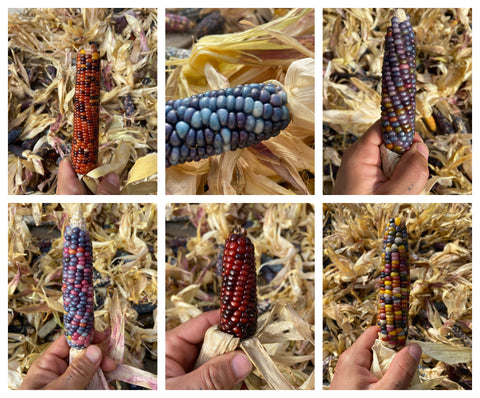
Pictured: some of Darich's rainbow corn.
I wonder what it might look like if we could look at the world the way Darich looks at his corn; the goal not being to “purify” a homogeneous human culture, as industrial agriculture is attempting to do all over the world, but to continue working towards diversification and fair, equal, open exchange, to see what beauty we can create. To look at our ancestry to understand where we come from, but also, to look towards the future, and towards new possibilities, new synergies, new creations. Here’s one last gem of wisdom from Darich; “Good abundance means sharing with others - the more I have, the more I can share. That is such a happiness. All the colors, varieties, and patterns you can get from one seed? It’s a whole world, a whole rainbow in one seed.”
Resources:
Making pique with food cart chef Tony Banegas
More info about making vinegars
More info about the history of Puerto Rico
Finding Your Roots: Slavery and Sugar Cane Plantations in Puerto Rico. This short video by PBS shows a woman learning about her genealogy and roots in Puerto Rico.

